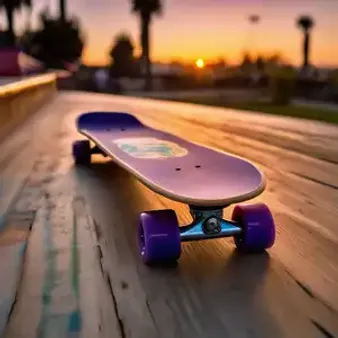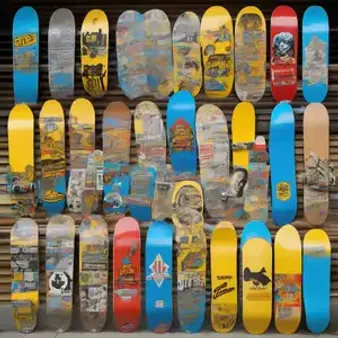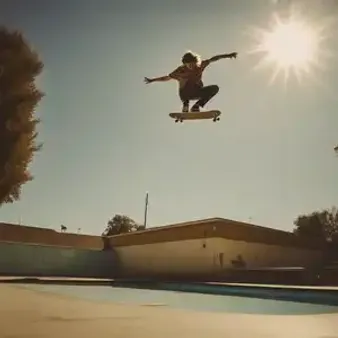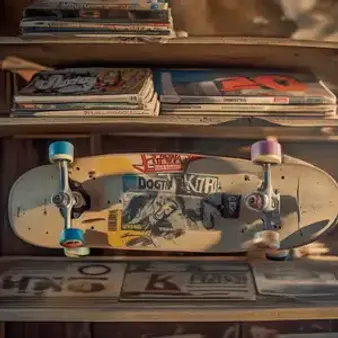Table of Contents
Step back in time to 1976, a year when disco ruled the airwaves and a revolution was brewing on the streets—the rise of 1976 skateboards. kizworld takes you on a thrilling ride through this pivotal year, exploring the innovations, the icons, and the enduring legacy of 1976 skateboards.
Feature | Description |
|---|---|
Year | 1976 |
Key Innovations | Urethane wheels, precision trucks, layered decks |
Notable Brands | Dogtown, Zephyr, Bahne |
Influential Skaters | Tony Alva, Jay Adams, Stacy Peralta |
Cultural Impact | Rise of skateboarding as a counter-culture movement, transition from freestyle to street skating |
The Rise of 1976 Skateboards
Picture this: it's 1976. The music scene is grooving to disco, and a new wave of energy is hitting the streets. That's right, we're talking about the rise of 1976 skateboards! This wasn't just about kids messing around on wooden toys anymore. It was the start of something big, something that would change the way we think about skateboarding. Think of it like this – imagine a caterpillar transforming into a butterfly. That's what 1976 did for skateboarding! It took something simple and made it extraordinary.
One of the coolest things about 1976 skateboards were the awesome innovations. Before 1976, skateboard wheels were made of clay or metal. Ouch, right? But then, urethane wheels rolled in, and everything changed! Imagine bouncing on a cloud – that's how smooth these new wheels felt. Plus, they gripped the ground better, making it easier to carve those sidewalks. This was also the year skateboard trucks, the things that connect the wheels to the board, got a serious upgrade. They became more precise, allowing skaters to steer with more control and pull off tricks they could only dream of before. It's like going from riding a clunky old bike to a sleek, high-tech one!
- skateboard-back-pack
- skate-tony-hawk
- wknd-skateboards
And don't forget about the decks! Remember those flat, wooden boards from before? Well, in 1976, they got a major makeover. Skaters started using multiple layers of wood glued together, making the boards stronger and more flexible. This meant they could handle more intense tricks and bigger ramps without breaking. It's like the difference between a flimsy paper airplane and a sturdy, aerodynamic glider! These advancements weren't just about making skateboarding more fun; they were pushing the limits of what was possible. If you are interested in skateboard, you can learn about how to get started with skateboarding to have more useful information.
Components | Desciption |
|---|---|
Urethane wheels | Smoother and grippier ride |
Precision trucks | Better steering and control |
Layered decks | Stronger and more flexible boards |
The Rise of 1976 Skateboards
Iconic 1976 Skateboard Designs and Innovations
Now, let's talk about the boards themselves! 1976 wasn't just about better parts; it was about style. Companies like Dogtown and Zephyr started making boards with wild designs and cool logos. Imagine a skateboard that looked like a work of art – that's what they were going for! These boards weren't just for riding; they were a statement. They showed off the skater's personality and added a whole new level of coolness to the sport. It was like the difference between wearing a plain t-shirt and a t-shirt with your favorite band on it! If you want to know more about skateboarding, you can check out how to do a 180 for more information.
One of the most iconic designs from 1976 was the Zephyr Competition Team board, also known as the "Z-Flex." It had this bright blue deck with yellow stripes, and it just screamed "cool." Then there was the Dogtown "Shogo" model, named after the legendary surfer and artist, Shogo Kubo. It had this super unique shape with a pointed nose, which was perfect for carving those tight turns. These boards weren't just about looking good; they were designed with performance in mind. To learn more about skateboarding, you can check out how to train like a skateboarder for more useful information.
Brand | Iconic Designs |
|---|---|
Zephyr | Zephyr Competition Team ("Z-Flex") |
Dogtown | "Shogo" Model |
Iconic 1976 Skateboard Designs and Innovations
1976 Skateboard Legends and Their Influence
Okay, so we've talked about the cool boards and the tech stuff, but what about the skaters? 1976 was like the birth of skateboarding superstars! These guys weren't just riding; they were inventing new tricks and pushing the limits of what a skateboard could do. Think of them like the rock stars of skateboarding, inspiring a whole generation of kids to grab a board and try it out.
You had guys like Tony Alva, who was known for his fearless style and crazy aerials. He wasn't afraid to take risks and try new things, and he landed some of the first-ever skateboarding tricks that blew everyone's minds! And then there was Jay Adams, a true skateboarding original. He had this smooth, surf-inspired style that made everything look effortless. He was like the cool kid on the block who everyone wanted to be. These guys weren't just athletes; they were artists, using their skateboards to express themselves and create something new. If you're interested in learning more about skateboarding, you can check out this guide on how to get started with skateboarding.
Skateboard Legends | Known For |
|---|---|
Tony Alva | Fearless style, crazy aerials, inventing new tricks |
Jay Adams | Smooth, surf-inspired style, effortless skateboarding |
These legends didn't just influence skateboarding; they shaped its future! Before them, skateboarding was mostly about freestyle—doing tricks on flat ground. But these guys, they saw the world as their skatepark. They started skating empty swimming pools, using the curved walls to do airs and grinds. It was like they were writing a new chapter in skateboarding history, showing the world what was possible. It's like the difference between playing hopscotch and inventing a whole new game! And it wasn't just about the tricks; it was about their attitude. They were rebels, going against the grain and doing things their own way. If you're curious about different skateboarding styles, you might enjoy this article on how to train like a skateboarder.
This rebellious spirit, this creativity, it resonated with kids everywhere. They saw these skateboarders as heroes, as pioneers, and they wanted to be just like them. And that's how 1976 changed skateboarding forever—it wasn't just a sport anymore; it was a movement, a way of life!
- skateboard-back-pack
- skate-tony-hawk
- wknd-skateboards
1976 Skateboard Legends and Their Influence
Collecting and Valuing 1976 Skateboards Today
Fast forward to today, and those 1976 skateboards? They're like finding hidden treasure! Seriously, people get super excited about finding these vintage boards. Imagine finding a comic book from the year your parents were born – it's like a time capsule of coolness! Some of these boards are now worth a lot of money, especially if they're in good condition or owned by a famous skater. It's like finding out your grandpa's old baseball card collection is worth a fortune!
So, how do you know if a 1976 skateboard is valuable? Well, it's like being a detective! First, you look at the brand. Dogtown, Zephyr, Bahne – those names are like magic words in the skateboarding world. Then, you check the condition. A board with all its original parts and not too many scratches is like finding a rare gem. And if it has the original stickers or paint? Jackpot! It's like finding a pirate treasure chest still full of gold! If you want to know more about skateboarding, you can learn about how to do a 180.
Factor | Impact on Value |
|---|---|
Brand (e.g., Dogtown, Zephyr) | Increases value due to historical significance and rarity |
Condition (original parts, minimal wear and tear) | Significantly impacts value; well-preserved boards are highly sought after |
Rarity (limited editions, special collaborations) | Extremely rare boards can fetch astronomical prices |
Historical Significance (boards owned by famous skaters, used in competitions) | Adds provenance and desirability, driving up value |
But here's the thing about collecting 1976 skateboards – it's not just about the money. It's about holding a piece of skateboarding history in your hands. It's about appreciating the craftsmanship, the style, and the rebellious spirit that made those boards so special. It's like owning a piece of the skateboard revolution! If you're interested in skateboarding, you can check out how to train like a skateboarder for more information.
- skateboard-back-pack
- skate-tony-hawk
- wknd-skateboards
Collecting and Valuing 1976 Skateboards Today
Final Thought
1976 wasn't just another year for skateboarding; it was a turning point. The sport evolved from a playful pastime to a cultural phenomenon, fueled by groundbreaking designs and the daredevil spirit of its pioneers. Today, 1976 skateboards stand as coveted relics, reminding us of the year skateboarding found its footing and carved its path toward global recognition.